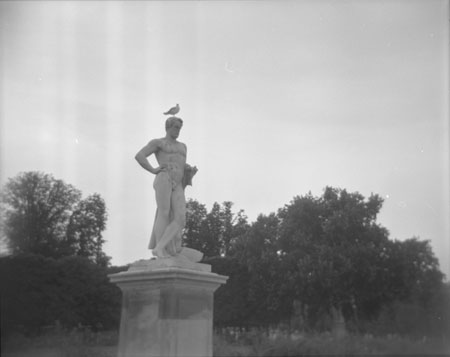Reflections on Art From the Mailbox: Nickalous Typaldos’ Untitled Photo from the Jardins Des Tuileries
04.04.11
 Taken last September in the Tuileries Gardens of Paris, Nickalous Typaldos’ black and white photo of Roman statuary recalls the “gentle humor” of cartoons by Jean-Jaques Sempé, who might have even chosen such a scene to depict in one of his drawings, perhaps as a piece that requires no captions. Though the background is softly blurred, as a graphite pencil drawing might be, this piece of mail art has characteristics that only a photograph can capture. For example, the mechanical eye makes us aware of three perspectives working in the scene.
Taken last September in the Tuileries Gardens of Paris, Nickalous Typaldos’ black and white photo of Roman statuary recalls the “gentle humor” of cartoons by Jean-Jaques Sempé, who might have even chosen such a scene to depict in one of his drawings, perhaps as a piece that requires no captions. Though the background is softly blurred, as a graphite pencil drawing might be, this piece of mail art has characteristics that only a photograph can capture. For example, the mechanical eye makes us aware of three perspectives working in the scene.
First, there is the gaze of the nude figure. Though his facial features are faint, we can read a sense of gravity in his furrowed brows. Some important matter, invisible to us, is set before him slightly to the right-hand side.
Second, we see art from the eyes of a bird. Where we see a relic of classical Western sculpture, the bird sees a cool, stone perch. It could care less of about the statue’s contrapposto, the year it was made, the collector who archived it, or the artist who shaped it. Upon this hunk of stone, the landing is isolated and clear. Simple.
And then, there is the perspective coming from the fourth wall, the eye of the artist, who fused bird and statue together via medium format film to form yet another meaning, this one concerning the absurdity of our decorations and the many monuments we’ve made to ourselves. I’m reminded now of the hyperbolic voice from Wayne Koestenbaum’s “Deceptions of Midnight”:
I love art
history: if only
I were
not exploding!
Perhaps Nickalous is also suggesting that art changes. His photo is related to the deep thinking in John Berger’s Ways of Seeing and Bruce Nauman’s Walk with Contrapposto, a work worth mentioning for the absurdity it lends the conversation. In school, we learn of Berger’s writing as the book that debunks the academic and political mystification of Western painting. Nickalous continues that train of thought when he robs the sculpture of its seriousness by capturing the bird on top of the statue. Call that one of the kinder forms of vandalism.
According to the history of landscape design, French formal gardens like those of the Tuleries, emphasize order over nature specifically to demonstrate “the mastery of man over nature.” Imagine flowerbeds and grassbeds amassing into strict geometrical shapes and symmetrical patterns; smooth labyrinth walls constructed from manicured shrubbery; or trimmed trees planted along rigid lines. For all the emphasis on order-over-nature in these gardens, natural forces—like this lone bird—still perch on our revered masterpieces, thus providing just the slightest tit-for-tat to the human insistence that we rule everything.